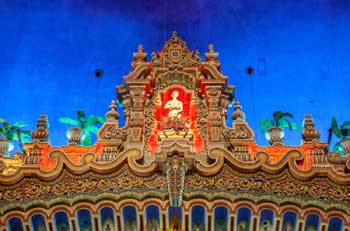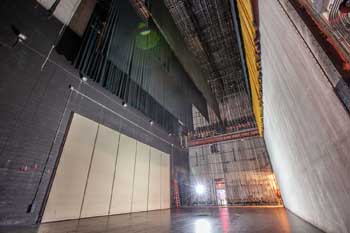

<< Go Back up to Region ‘Texas’
| Follow Mike Hume’s Historic Theatre Photography: |  |
 |

Architect: John Eberson
Atmospheric Style: Spanish Villa
First Opened: 14th June 1929 (95 years ago)
Reopened: 14th September 1989
Former Names: Greater Majestic
Websites: www.majesticempire.com  www.themajesticempirefdn.org
www.themajesticempirefdn.org 
Telephone: (210) 226-5700 
Address: 224 East Houston Street, San Antonio, TX 78205 
The Majestic was designed by theatre architect John Eberson, famous for his Atmospheric Theatres throughout the United States. The Majestic was completed in 1929 for the Interstate Theaters Company under the management of Karl Hoblitzelle, and was built on the site of the Royal Theater (1909). It is the fifth theatre in San Antonio to bear the name “Majestic”.

 Detailed Information
Detailed InformationRather than seat patrons in a “boxlike” formal setting, atmospheric theatres were designed to transport the patron to a more exotic place, such as a European courtyard or garden, with seemingly infinite vistas. Atmospheric theatres were generally asymmetrical as opposed to the traditionally symmetrical classical theatre design.
It was usual for an Atmospheric theatre’s ceiling to be painted to resemble the sky, tiny lamps recreating celestial constellations with faithful accuracy, and clouds projected over the vista to enhance the spectacle. John Eberson was the architect most associated with the style, and 16 of his atmospheric theatres are still in operation throughout the United States, the San Antonio Majestic being one of them. The Majestic is considered one of his best examples.

The theatre’s design was inspired by Spanish Mission, Baroque, and Mediterranean styles, hailed as “Mexican Cloister architecture” at its opening, and was modeled on a Spanish village. It features replicas of well-known Greek, Roman, and Renaissance sculptures hidden amongst greenery, in addition to real cypress trees that were imported from Spain. Additional foliage included ten South American palms, as well as Orange, Azalea, Magnolia, and Oleander trees. One of the more unusual features is 28 stuffed birds, perched on balconies throughout the auditorium and some even preserved in-flight, hung on wires. The most notable of these is a rare white peacock located on the House Left side. Having shown its age, the white peacock was replaced in 2007 at a cost of $3,600.
The auditorium’s ceiling faithfully recreates several star constellations, positioned according to consultations with experts from the National Geographic Society in the late 1920s.
Above the proscenium is a statue of the goddess Venus, looking across the auditorium. On either side of the proscenium are singers’ balconies, originally accessed by stairways from the Stage.
A 3-manual 10-rank Robert Morton organ was installed in the theatre and featured in Robert Morton advertisements during the second half of 1929.

At its opening the Majestic was the first theatre in Texas to be fully air-conditioned, the largest theatre in Texas, and the second largest theatre in the United States, boasting 3,703 seats across Orchestra (main floor) and two balconies. Seating had been claimed to be over 4,000 at the time of opening. A 1929 report on the San Antonio Majestic proclaims: “The upper balcony is reserved for the colored patronage and is reached by separate stairways and elevator through a separate lobby entrance”. Segregation was required by Texas state law in the 1920s.
The marquee was designed to house an outdoor café on a balcony above although it is unclear if this ever came to fruition. The lobby housed a unique feature: a “giant wall aquarium, illuminated from behind and above”. Exotic fish were on view, and the surface water line was hidden hence affording the effect of a submarine view.
A penthouse apartment was designed into the top of the 18-story building, the “Majestic Building”, containing the theatre. This was for Karl Hoblitzelle, head of the Interstate chain, and included a rooftop garden.
At the time of opening the theatre’s vertical sign was said to be the largest theatrical sign in the South, measuring 76ft high and 14ft wide at the top, and 8ft wide at the base. It contained 2,400 lamps and boasted a brilliance of 114,700 candlepower. The “Majestic” sign atop the theatre’s roof featured 1,280 lamps.
Despite many years of entertaining the crowds, the Majestic closed in 1974. In 1981 it was reopened but a superficial remodeling covered-up many of the important architectural details. It was closed again in 1988 and the City of San Antonio stepped-in to purchase the theatre. The nonprofit Las Casas Foundation was formed with the priority of restoring the Majestic as close as possible to its original 1929 design. $4.5 million was raised for the restorations and in the Fall of 1989 the Majestic reopened with “Majestic Week” featuring concerts from the San Antonio Symphony and a Gala performance featuring Rosemary Clooney and Johnny Mathis. Banjoist Don Galvan, who had taken part at the theatre’s 1929 opening, returned to San Antonio for the reopening celebrations.
The Majestic became home to the San Antonio Symphony until 2014 and their move to the new Tobin Center. In 1993 the theatre was designated a National Historic Landmark.

The Majestic had been unable to accommodate large stage productions due its limited stage depth. In 1995 a $3.5 million expansion was undertaken which saw the Majestic’s stage expand by reducing the depth of the Empire Theatre’s stage, with whom the Majestic shares a rear stage wall. In addition sound-isolation barriers/doors, modernized theatrical rigging, a state-of-the-art orchestra shell, expanded dressing room facilities, and enlarged storage space was added. The Majestic’s current seating capacity is 2,311.
In mid-2023 it was announced  that the theatre’s cloud projectors had been upgraded after the blue sky ceiling had been static for several years. Rob Oler, Technical Director of the theatre for five years, advised that the light sources had been upgraded to multi-color LED.
that the theatre’s cloud projectors had been upgraded after the blue sky ceiling had been static for several years. Rob Oler, Technical Director of the theatre for five years, advised that the light sources had been upgraded to multi-color LED.
Legendary stars that performed at the Majestic include Jack Benny, Mickey Rooney, Ann Miller, George Burns, and Bob Hope. Premieres which have taken place at the Majestic include West Point of the Air (1935)  , The Texans (1938)
, The Texans (1938)  , The Lusty Men (1952)
, The Lusty Men (1952)  , To Hell and Back (1955)
, To Hell and Back (1955)  , and The Alamo (2004)
, and The Alamo (2004)  .
.
The Majestic is now the home of Broadway Across America  in San Antonio. Musical sensations such as Miss Saigon, Les Miserables, Cats, Cabaret, and Ragtime have graced the Majestic stage, as well as such international classic artists as Itzhak Pearlman and Isaac Stern. Contemporary artists such as Lyle Lovett, B.B. King, Tony Bennett and Sting have performed in the theatre. Comedians Jerry Seinfeld, George Lopez and Chris Rock have also had their names in lights on the Majestic’s marquee.
in San Antonio. Musical sensations such as Miss Saigon, Les Miserables, Cats, Cabaret, and Ragtime have graced the Majestic stage, as well as such international classic artists as Itzhak Pearlman and Isaac Stern. Contemporary artists such as Lyle Lovett, B.B. King, Tony Bennett and Sting have performed in the theatre. Comedians Jerry Seinfeld, George Lopez and Chris Rock have also had their names in lights on the Majestic’s marquee.
In the Spring of 2024, La Casas Foundation rebranded as the Majestic Empire Foundation  in order to reinforce its mission to cultivate and nurture the young performing artists of San Antonio and South Texas while honoring its stewardship of the Majestic and Empire theatres.
in order to reinforce its mission to cultivate and nurture the young performing artists of San Antonio and South Texas while honoring its stewardship of the Majestic and Empire theatres.
 Video from our YouTube channel:
Video from our YouTube channel: Listed/Landmark Building Status
Listed/Landmark Building Status (1st October 1975)
(1st October 1975) (1991)
(1991) How do I visit the Majestic Theatre?
How do I visit the Majestic Theatre?The Majestic Theatre welcomes the community and visitors to the heart of downtown to spend an evening going behind the scenes and experiencing the historic venue like never before!
The theatre’s historic tours  feature a unique behind the scenes look at the theatres’ history, architecture and character with knowledgeable tour guides and a trip backstage. A complimentary cocktail is included with each ticket. A portion of ticket proceeds support Las Casas Foundation Performing Arts Scholarship Program.
feature a unique behind the scenes look at the theatres’ history, architecture and character with knowledgeable tour guides and a trip backstage. A complimentary cocktail is included with each ticket. A portion of ticket proceeds support Las Casas Foundation Performing Arts Scholarship Program.
The tour will involve the use of stairs. For additional information, or for accommodation requests, please contact theatreservicessa@theambassadors.com  .
.
 Further Reading
Further Reading , founded in 1988 as part of the effort behind the restoration of San Antonio’s historic Majestic and Empire Theatres.
, founded in 1988 as part of the effort behind the restoration of San Antonio’s historic Majestic and Empire Theatres. contains a selection of historic playbills, photos and posters, along with some additional history and user comments on the theatre.
contains a selection of historic playbills, photos and posters, along with some additional history and user comments on the theatre. contains some further information on the theatre.
contains some further information on the theatre. .
. , a whimsical film vignette in the spirit of the 2020 holiday season.
, a whimsical film vignette in the spirit of the 2020 holiday season. , as printed in the 1st July 2023 edition of the San Antonio Express-News.
, as printed in the 1st July 2023 edition of the San Antonio Express-News. a 27-minute documentary about the great American movie palaces of the 1920s and 1930s.
a 27-minute documentary about the great American movie palaces of the 1920s and 1930s. (originally published as two volumes in 1927 and 1930; reissued as a single volume in 2009 by the Theatre Historical Society of America), by R.W. Sexton and B.F. Betts, published by Liber Apertus Press. ISBN 0978588169.
(originally published as two volumes in 1927 and 1930; reissued as a single volume in 2009 by the Theatre Historical Society of America), by R.W. Sexton and B.F. Betts, published by Liber Apertus Press. ISBN 0978588169. , by Mark Louis Rybczyk, published by Trinity University Press. ISBN 1595347577.
, by Mark Louis Rybczyk, published by Trinity University Press. ISBN 1595347577. by David Naylor, published by Preservation Press. ISBN 0891331271.
by David Naylor, published by Preservation Press. ISBN 0891331271. , by Ben M. Hall, published by Da Capo Press. ISBN 0306803151.
, by Ben M. Hall, published by Da Capo Press. ISBN 0306803151. by David Naylor, published by Van Nostrand Reinhold. ISBN 0442238614.
by David Naylor, published by Van Nostrand Reinhold. ISBN 0442238614. Technical Information
Technical Information Photos of the Majestic Theatre
Photos of the Majestic TheatrePhotographs copyright © 2002-2024 Mike Hume / Historic Theatre Photos unless otherwise noted.
Text copyright © 2017-2024 Mike Hume / Historic Theatre Photos.
For photograph licensing and/or re-use contact me here  .
.
| Follow Mike Hume’s Historic Theatre Photography: |  |
 |